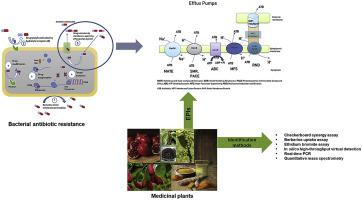Journal of Pharmaceutical Analysis ( IF 8.8 ) Pub Date : 2019-11-05 , DOI: 10.1016/j.jpha.2019.11.002 Armel Jackson Seukep 1, 2, 3 , Victor Kuete 3 , Lutfun Nahar 4 , Satyajit D Sarker 5 , Mingquan Guo 1, 2

|
The upsurge of multiple drug resistance (MDR) bacteria substantially diminishes the effectiveness of antibiotic arsenal and therefore intensifies the rate of therapeutic failure. The major factor in MDR is efflux pump-mediated resistance. A unique pump can make bacteria withstand a wide range of structurally diverse compounds. Therefore, their inhibition is a promising route to eliminate resistance phenomenon in bacteria. Phytochemicals are excellent alternatives as resistance-modifying agents. They can directly kill bacteria or interact with the crucial events of pathogenicity, thereby decreasing the ability of bacteria to develop resistance. Numerous botanicals display noteworthy efflux pumps inhibitory activities. Edible plants are of growing interest. Likewise, some plant families would be excellent sources of efflux pump inhibitors (EPIs) including Apocynaceae, Berberidaceae, Convolvulaceae, Cucurbitaceae, Fabaceae, Lamiaceae, and Zingiberaceae. Easily applicable methods for screening plant-derived EPIs include checkerboard synergy test, berberine uptake assay and ethidium bromide test. In silico high-throughput virtual detection can be evaluated as a criterion of excluding compounds with efflux substrate-like characteristics, thereby improving the selection process and extending the identification of EPIs. To ascertain the efflux activity inhibition, real-time PCR and quantitative mass spectrometry can be applied. This review emphasizes on efflux pumps and their roles in transmitting bacterial resistance and an update plant-derived EPIs and strategies for identification.
中文翻译:

来自植物的次生代谢产物作为外排泵抑制剂的主要来源和鉴定方法。
多重耐药性(MDR)细菌的大量涌现大大降低了抗生素武库的效力,因此加剧了治疗失败的速度。MDR的主要因素是外排泵介导的耐药性。独特的泵可以使细菌承受多种结构多样的化合物。因此,它们的抑制作用是消除细菌中耐药现象的有前途的途径。植物化学物质是抗性改良剂的极佳替代品。它们可以直接杀死细菌或与致病性的关键事件相互作用,从而降低细菌产生抗药性的能力。许多植物药显示出值得注意的外排泵抑制活性。食用植物越来越受到关注。同样地,一些植物科将是外排泵抑制剂(EPI)的极好来源,包括夹竹桃科,小ber科,旋花科,葫芦科,豆科,唇形科和姜科。筛选植物来源的EPI的简便方法包括棋盘格协同测试,小ber碱摄取测定和溴化乙锭测试。可以将计算机高通量虚拟检测作为排除具有外排底物样特征的化合物的标准进行评估,从而改善选择过程并扩展EPI的鉴定。为了确定外排活性抑制,可以应用实时PCR和定量质谱法。这篇评论强调外排泵及其在传播细菌抗性中的作用,以及更新的植物来源的EPI和鉴定策略。小ber科,旋花科,葫芦科,豆科,唇形科和姜科。筛选植物来源的EPI的简便方法包括棋盘格协同测试,小ber碱摄取测定和溴化乙锭测试。可以将计算机高通量虚拟检测作为排除具有外排底物样特征的化合物的标准进行评估,从而改善选择过程并扩展EPI的鉴定。为了确定外排活性抑制,可以应用实时PCR和定量质谱法。这篇评论强调外排泵及其在传播细菌抗性中的作用,以及更新的植物来源的EPI和鉴定策略。小ber科,旋花科,葫芦科,豆科,唇形科和姜科。筛选植物来源的EPI的简便方法包括棋盘格协同测试,小ber碱摄取测定和溴化乙锭测试。可以将计算机高通量虚拟检测作为排除具有外排底物样特征的化合物的标准进行评估,从而改善选择过程并扩展EPI的鉴定。为了确定外排活性抑制,可以应用实时PCR和定量质谱法。这篇评论强调外排泵及其在传播细菌抗性中的作用,以及更新的植物来源的EPI和鉴定策略。筛选植物来源的EPI的简便方法包括棋盘格协同测试,小ber碱摄取测定和溴化乙锭测试。可以将计算机高通量虚拟检测作为排除具有外排底物样特征的化合物的标准进行评估,从而改善选择过程并扩展EPI的鉴定。为了确定外排活性抑制,可以应用实时PCR和定量质谱法。这篇评论强调外排泵及其在传播细菌抗性中的作用,以及更新的植物来源的EPI和鉴定策略。筛选植物来源的EPI的简便方法包括棋盘格协同测试,小ber碱摄取测定和溴化乙锭测试。可以将计算机高通量虚拟检测作为排除具有外排底物样特征的化合物的标准进行评估,从而改善选择过程并扩展EPI的鉴定。为了确定外排活性抑制,可以应用实时PCR和定量质谱法。这篇评论强调外排泵及其在传播细菌抗性中的作用,以及更新的植物来源的EPI和鉴定策略。可以将计算机高通量虚拟检测作为排除具有外排底物样特征的化合物的标准进行评估,从而改善选择过程并扩展EPI的鉴定。为了确定外排活性抑制,可以应用实时PCR和定量质谱法。这篇评论强调外排泵及其在传播细菌抗性中的作用,以及更新的植物来源的EPI和鉴定策略。可以将计算机高通量虚拟检测作为排除具有外排底物样特征的化合物的标准进行评估,从而改善选择过程并扩展EPI的鉴定。为了确定外排活性抑制,可以应用实时PCR和定量质谱法。这篇评论强调外排泵及其在传播细菌抗性中的作用,以及更新的植物来源的EPI和鉴定策略。


























 京公网安备 11010802027423号
京公网安备 11010802027423号